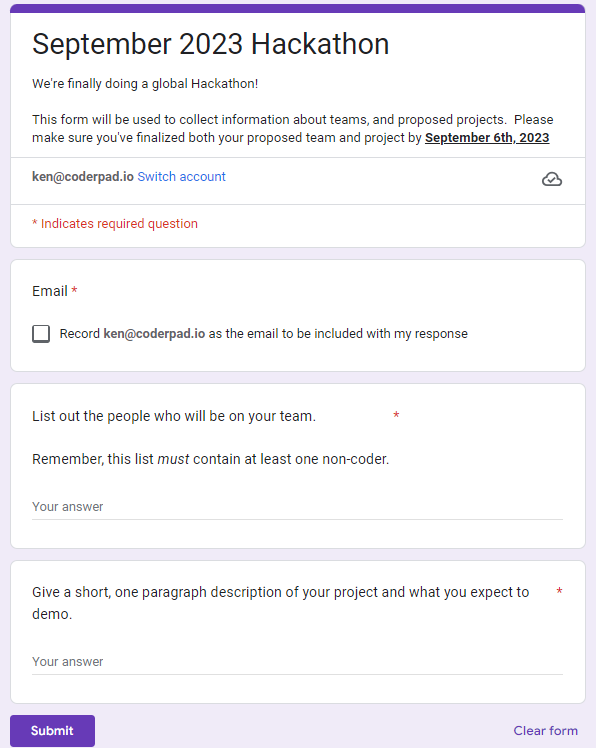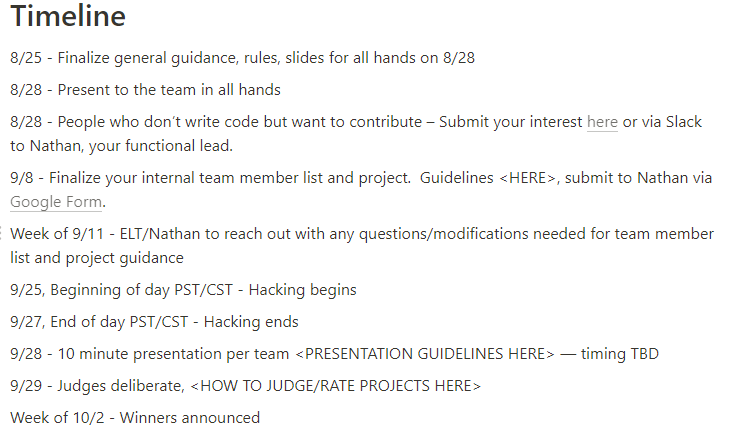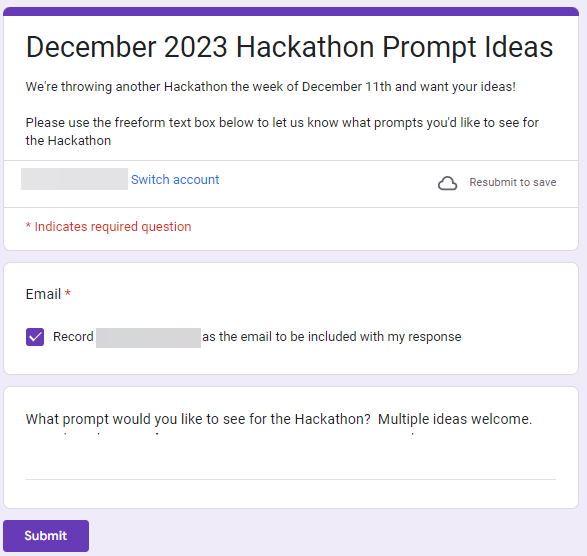5 Fresh Takes On How To Run A Successful Hackathon

Hackathons, once primarily associated with the tech industry, have become widely embraced across various sectors.
These intensive, time-bound events offer an unparalleled opportunity for employees to collaborate, brainstorm, and develop innovative solutions to real-world challenges.
And employees like them – when they’re done right.
I once participated in a hackathon that touted free food, free energy drinks, a chance to win an iPad, an Amazon Echo Dot consolation prize, and the “fun” of staying up for 24 hours to finish your project. Who wouldn’t participate in that hackathon?!
Of course, it was 2017 and, being this was at a large insurance company, the theme was basically “improve our insurance business” – the incentives needed to be big to get us to stay after work hours for a topic that wasn’t going to be impressing our neighbors anytime soon.
While I joined for the incentives, it was a rather enjoyable experience. I got to hang out with my favorite coworkers – and a few new ones as well; I got to work with technology I wouldn’t usually use, and I got recognized for my work even if we missed out on the grand prize.
Fast forward to 2023 at CoderPad, where we recently ran our first company hackathon, with our Vice President of Engineering, Nathan Sutter, leading the charge. It was a hit, with our employees saying things like:
“It allowed me to “scratch an itch” with a project I’ve been dying to work on.“
“It was challenging yet exciting to mix things up and work on something that’s not my usual day-to-day work.“
“It was great to get a real feel for how talented your colleagues are.“
Nathan has helped compile a list of 5 tips to run a successful hackathon so you can hopefully experience some of the same great results we have, like:
- Getting ideas for product improvements, and they’re usually minimally viable
- Build up the confidence of employees who typically don’t provide input
- Increase company cohesion by putting together teams and people who don’t usually work together
- Improve employee morale and loyalty to your company
So, let’s begin.
Tip #1: Make it cross functional
One of the best ways to ensure the success of a hackathon is to allow employees from all departments to participate and to encourage them to create teams with others outside their typical working crews.
There are two reasons this helps make a great hackathon:
1) Employees love it because they get to work with people they usually don’t work with. Working with new people with backgrounds vastly different from yours that you don’t normally interact with is exciting.
2) When people with different backgrounds come together, they’re more likely to create projects that wouldn’t happen if they stuck with their regular team members. The ideas they generate will be more unique than if each team solely consisted of software engineers, accountants, or human resources personnel.
Additionally, once the hackathon is done, a lot of these cross-functional relationships persist, which leads to increased company cohesion, collaboration, and increased information sharing, which can drastically reduce the adverse effects of departmental silos.
How we did this at CoderPad:
To encourage cross functional teams, we required each team to have at least one non-coder member. In addition to our software engineers, we ended up with participants who were content marketers, product managers, UI designers, and copywriters.
To ensure compliance, we made a note of the rule in the Google form that teams used to sign up:
Tip #2: Block time on the calendar during normal work hours
There are a few no-nos, but primary among them is only hosting the hackathon after business hours.
If you’re expecting employees to come in after their typical workday, you either better make sure you have fantastic participation incentives and prizes, or you should expect very few people to participate. You’re also limiting your potential demographic of people who can attend – people with a family or other responsibilities outside of work will not participate.
When you schedule it during the work week, ensure the whole company is aware so that those participating can entirely focus on the hackathon project. Allow them to cancel or move meetings, and offer to pay for meals if the hackathon goes through breakfast, lunch, or dinner time.
You should also clarify to your product management department that there should be NO roadmap development during the hackathon. This ensures they plan a reasonable workload for the development team in their current sprints.
How we did this at CoderPad:
We laid out the timeline for our hackathon a whole month before the hackathon itself:
When we presented the hackathon plans at CoderPad’s weekly all-employee meeting, there were two beneficial effects:
- People knew ahead of time when the hackathon was so they could move their schedules around accordingly.
- People saw the senior leadership team’s excitement, encouragement, and buy-in, which helped encourage people to participate and be less afraid of building time into their schedules for the hackathon.
On the day of the hackathon, we had minimal issues with employees finding time to participate.
Tip #3: Make the theme fun and motivating
Bad hackathon themes:
- “Increase our profits.”
- “Working harder: Improve productivity with minimal expenses.”
- “Get our customers to stop complaining about us on social media.”
If you’re going to create a hackathon experience that will attract participants, you absolutely must avoid the profit-driven, unimaginative ideas that often come from the C-suite.
A better option?
Ask your employees! Have them submit ideas and then vote on the ones they think are the best.
This is a great way to get employees to buy into the hackathon, which will help you increase your number of participants. Themes developed by peers seem much less “dictated” than those from senior leadership.
You’ll also be able to generate a much larger pool of ideas if you ask potential participants than if you rely on a small number of managers. AND they’ll know what is exciting and fun for them much more than leadership ever will.
How we did this at CoderPad:
We didn’t ask our employees for hackathon ideas – at least not the first time. For the first round, Nathan developed the theme “Use AI to develop a modification or extension to the Screen or Interview product.”
So this was more of a “lesson learned” for us, and we are currently implementing it as part of our next hackathon in December; here’s the form we used:
Tip #4: Reward the winners & acknowledge all participants
Recognition is the easiest and most apparent reward, but don’t be a cheapskate either.
Yes, fancy tech gifts will be more memorable. Nobody will forget when they won their hackathon and received a Roomba or a room-sized sound system.
Even if your budget doesn’t allow for the newest Mac laptop, you can still give less expensive rewards like company swag, gift cards, PTO days, or eReaders (to name a few). If you need to figure out what to provide, have another poll where you ask employees what they’d like.
You may not get something everyone likes, but you’re sure to get something that will encourage at least a few more people to participate.
Similarly, it’s a good idea to include participation rewards. These will obviously not be as nice as the awards for the winners, but it’s still a good idea to acknowledge hackathon participants with a small gift, given the effort they put into the hackathon.
How we did this at CoderPad:
We gave each winning team member $100 to be used as they pleased.
The participation award is that we are actively implementing ALL the projects into our products, which you can read more about in Tip #5.
Tip #5: Implement the projects
The best reward is having your hackathon project make it to the roadmap.
Money is always good, but the fact that an idea you came up with makes it to the roadmap is the real reward – the potential to make the roadmap is the thing that excites them most.
This will take some planning and preparation from product and engineering leadership to ensure you have roadmap capacity for getting hackathon projects to production.
But it’s essential because implementing the hackathon projects into production is often a bigger reward than tangible rewards. Having independent contributor-driven ideas make it to production is hugely motivating to both want to participate now and in future hackathons.
How we did this at CoderPad:
Nathan and our Vice President of Product Frank Hauben, along with some input from other senior managers, made the judgment call on the project’s viability for integration into the roadmap. From there, it was just a matter of adding it to our product backlog and following our standard product development processes.
We added 6 out of 11 hackathon projects to our product backlog – more than we expected and a massive boon to our customers.
Conclusion
Hosting an intra-office hackathon is about stirring up the pot in the best way possible. It’s the kind of event that gets people out of their cubicles, mixing it up with folks from other departments, and actually having a good time while they’re at it. Imagine that—a work event you’d want to stay late for!
An inclusive theme that resonates with the team, recognition of effort, and rewards that reflect appreciation, all contribute to a compelling hackathon experience. These components are essential for drawing in participants and ensuring their engagement from start to finish. Moreover, the acknowledgment of every participant’s contribution reinforces a sense of value and belonging within the company.
The success of a hackathon is often best reflected in the tangible outcomes it produces. The integration of hackathon projects into the company’s product suite not only validates the event’s worth but also serves as a significant motivator for ongoing participation. It’s this transition from idea to implementation that completes the hackathon journey, leaving a lasting impression of achievement and innovation on both the individuals involved and the company as a whole.
Some parts of this blog post were written with the assistance of ChatGPT.



